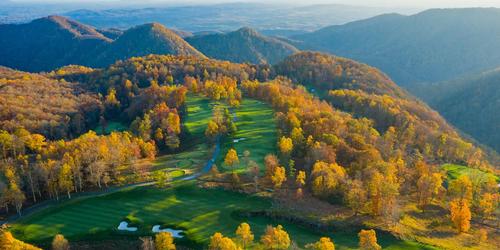
Stoney Creek at Wintergreen Resort
A Rees Jones Jewel
By Mike May
In Virginia, you will find golf's version of The Sound of Music because the hills are alive with the sounds of golfers happily pursuing Old Man Par. Golfers are also enjoying wonderful views of the meandering streams, hardwood forests, pristine wetlands, surrounding mountains, and the ski slopes during the winter. There are also sightings of deer and the occasional black bear, oh my. That's the best way to summarize the golf experience at Stoney Creek at Wintergreen (wintergreenresort.com; 434-325-8250) in the Blue Ridge Mountains of rural Virginia.
Designed by legendary golf course architect Rees Jones, Stoney Creek is one of those ever-popular 27-hole layouts composed of three separate nine-hole courses. Upon completion, Jones was thrilled with his creativity.
"I think what Stoney Creek is to me is one of the great settings in mountain golf," said Jones.
At Stoney Creek, the names of each of nine-hole course - Monocan, Shamokin, and Tuckahoe -- have a distinct connection to Native American Indians.
The Monocan tribe is one of many Native American tribes in Virginia. From 1727 to 1756, Shamokin, a multi-ethnic Native American trading village along the Susquehanna River in Pennsylvania, was one of the largest and most influential Indian settlements in the Keystone State. Tuckahoe is another term for bread eaten by Indians.
Because of the tendency of many of the holes to be somewhat uphill or downhill, the actual distances of each hole on the scorecards can be somewhat deceiving. When deciding which tees to use on your inaugural visit to Stoney Creek, play a more forward set of tees.
From a topography perspective, Shamokin and Monocan are played in the Rockfish Valley of the Blue Ridge Mountains, while Tuckahoe is played in the Blue Ridge foothills.
"I believe the best part about playing Stoney Creek on a frequent basis is that the golfer who has played the course knows exactly what he /she is expected of given the courses. At Stoney Creek, there are no blind shots to speak of as each course gives the golfer opportunities to score well on certain holes, as well as force the player to hit quality shots on other holes," says Geoff Redgrave, the head professional at Stoney Creek. "All the clubs in the bag are also used so it's not about bombing your driver everywhere. At Stoney Creek, it's about strategic placement. The green complexes protect the course from real low scores in my estimation although 63 from PGA Tour winner Peter Malnati on the Monocan and Shamokin rotation is real low!"
Shamokin is a perfect way to begin the Stoney Creek experience. The setting is quite peaceful and it all starts with the atmosphere at the driving range, which sits at the base of the Rockfish Valley and is surrounded by the Blue Ridge Mountains. There are very few uphill, downhill or sidehill lies at Shamokin because the course sits in the valley. On nearly every hole at Shamokin, the Blue Ridge Mountains provide a backdrop that you never get tired of seeing. The 'signature shot' at Shamokin is the tee shot at the par three 7th hole, where there's a 150-foot drop in elevation from tee to green.
Tuckahoe has the most profound start when compared with the other two golf courses. Tuckahoe gets your attention from the get-go, as the 'signature shot' is the tee shot at the 1st. That first tee ball is hit from a raised tee. In the distance, the raised green sits -- ready for your eventual arrival. If your initial tee shot drifts too far to the right, it will end up in the lake which borders the right side of the 1st fairway. Securing a par four Tuckahoe's 1st is a brilliant beginning to what will be memorable nine holes of mountain golf. At Tuckahoe, water comes into play on four holes and the hilly terrain comes into play on nearly every hole. At Tuckahoe, don't get distracted by the scenery and forget that the primary purpose of your excursion is to play golf. In other words, don't take too many mountainside selfies.
Monocan is the shortest of the three nine-hole layouts, but that doesn't mean it's the easiest of the three. Water, in the form of streams and lakes, is a dominant theme at Monocan, especially at the par three 5th, which demands a 100% carry over Lake Monocan to a small 'paw print' green which is protected by four sand bunkers. That tee shot at the 5th is Monocan's 'signature shot.' All nine putting surfaces at Monocan are guarded by a combination of well-placed mounds and sand traps. The tee shot at the 9th demands that you hit your tee shot through a chute of trees, just like the tee shot at the 18th at Augusta National.
A final twist to the overall experience at the Wintergreeen Resort is that on a nice winter's day, it's quite possible to go snow skiing in the morning at the top of the mountain and then descend 3,300 feet down the mountain to Stoney Creek for golf in the afternoon. While that's a great daily-double experience at the Wintergreen, you can expand your horizons by adding a trip to the Spa at the Wintergreen Resort to make it the ultimate one-day trifecta. After you have a ski, tee, and spa day at the Wintergreen Resort, you'll probably emerge humming a few bars from The Sound of Music, too.
Revised: 11/11/2016 - Article Viewed 30,323 Times
- View Course Profile
About: Mike May
![]() Mike May is a Wellington, Florida-based freelance golf and sportswriter, who is also a 25+ year public relations and communications executive in the sporting goods industry. He is also a veteran high school soccer official, an experienced high school basketball coach, an avid athlete, a part-time personal trainer, and a passionate golfer who is forever in pursuit of Old Man Par. He is a member of the Golf Writers Association of America.
Mike May is a Wellington, Florida-based freelance golf and sportswriter, who is also a 25+ year public relations and communications executive in the sporting goods industry. He is also a veteran high school soccer official, an experienced high school basketball coach, an avid athlete, a part-time personal trainer, and a passionate golfer who is forever in pursuit of Old Man Par. He is a member of the Golf Writers Association of America.
Contact Mike May:
GolfTrips.com - Contributor













